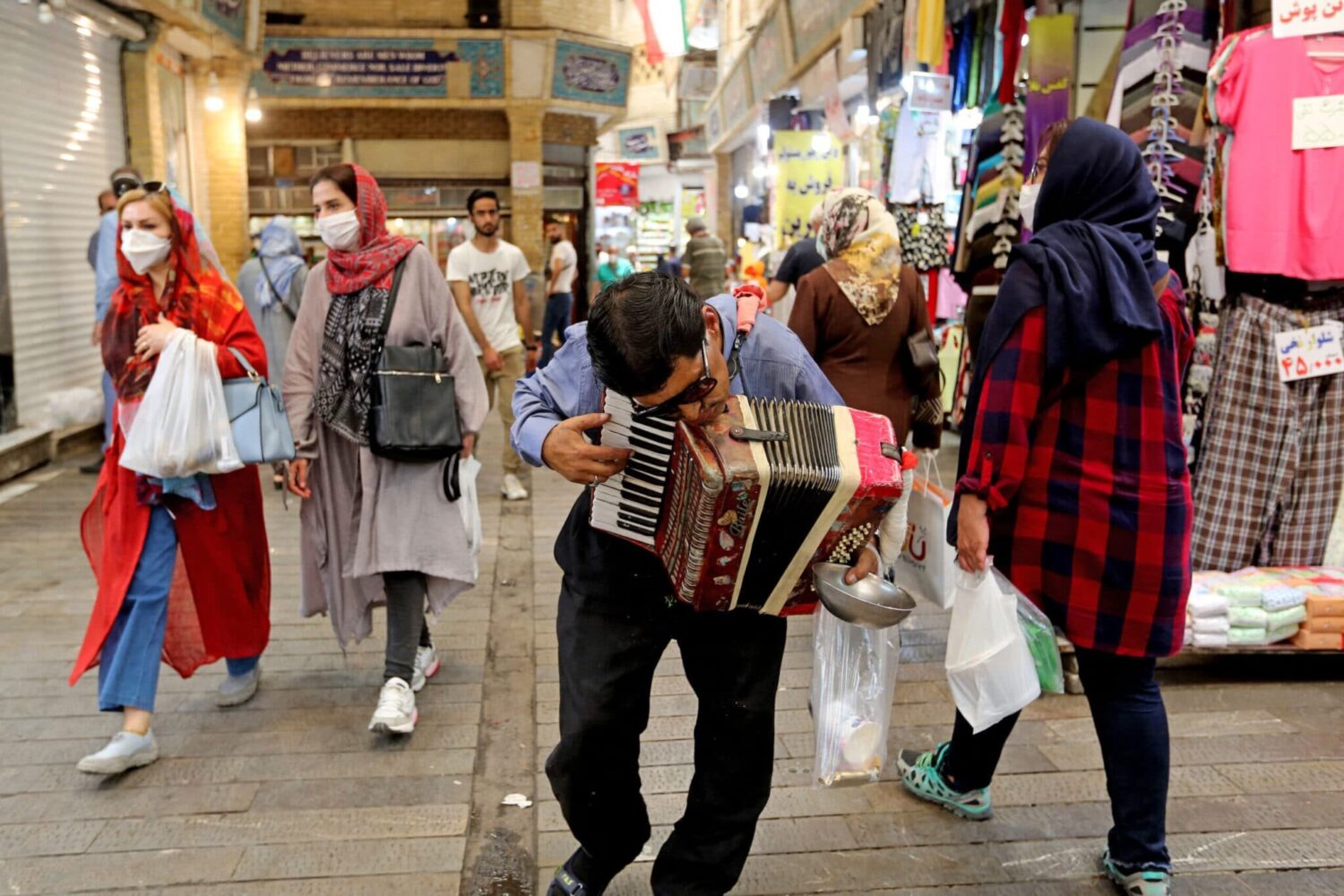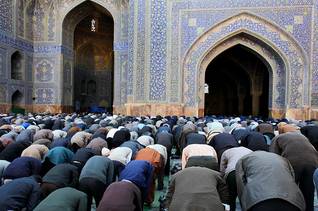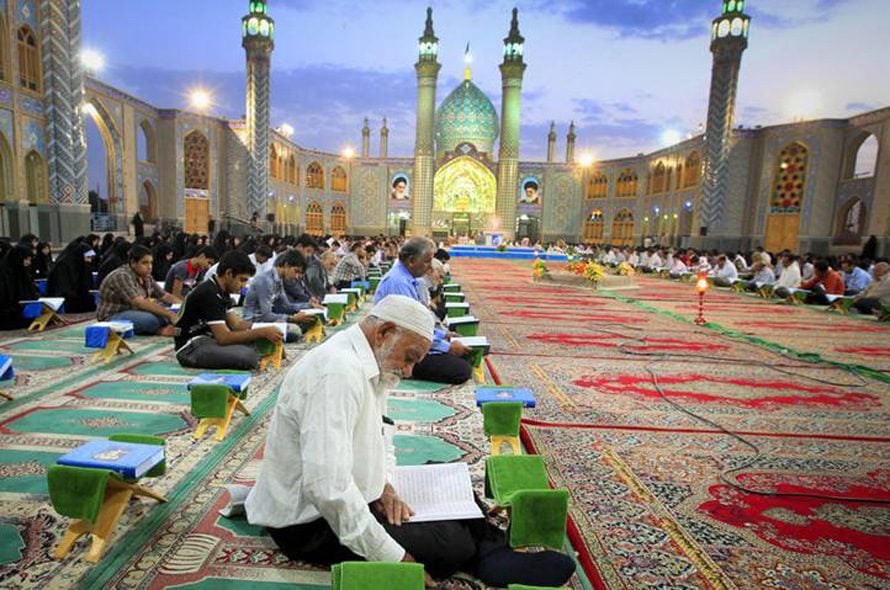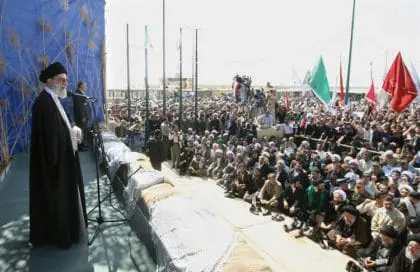
Introduction
At the beginning of 2024, the population of Iran was estimated at 89.8 million, with an average annual growth rate of 1.06% over the country’s population in 2023, according to United Nations data. The number of males reached 45.43 million or 50.8% of the total population, while the number of females reached 44.18 million or 49.2% of the total population.
Iranian official sources indicated that the rate of population growth in the country had decreased for the first time to less than 1% by the end of the Persian year 1398 (March 2020) but has since increased to an average of 1.2%. The average life span in Iran is estimated at 75.6 years (74.3 years for males, and 77.1 years for females). The infant mortality rate is 14.3 deaths per 1,000 births.
Muslims make up 98.5% (Shiites 90-95%, Sunnis 5-10%), while Christians account for 0.7%, and others ( Zoroastrian, Jewish, Hindu, etc.) amount to 0.2%, according to the CIA World Factbook.

Iran is an ethnically diverse country although the Iranian government does not disclose any information about ethnicity through its statistics; However, most sources confirm that the Persians represent 61% of the population, followed by the Kurds (10%), the Lour (6%), and the Baloch (2%). Other ethnicities account for the remaining 21%, including Azerbaijanis (16%), Arabs (2%), Turkmen and Turkish tribes (2%), as well as Armenians, Assyrians and Georgians.
The languages used in the Islamic Republic include: Persian (official), Azerbaijani Turkish dialects, Turkish, Kurdish, Gilaki, Mazandarani, Lori, Baluchi, Arabic, and other languages.
Age Groups
Iranian society can be described as young, as 59 percent of the population is below 24 years old, and 23 percent is in the 0-14 age group. While about 69 percent of the population is between 15 and 64, only 8 percent is aged 65 and over.
The fertility rate in Iran is 1.7 children per woman, falling short of the 2.1 births per woman required to maintain a stable population, according to Iranian data. The average life expectancy was 77.5 years (75 for men and 80 for women).
Areas of Habitation
The population density was estimated as 56 people/km2 in 2024, according to the UN’s Data Portal. The population in urban areas is 73.1 percent of the total population, most of which is concentrated in the north, north-west, and west of the country.
Tehran is one of the largest cities in the Middle East, and the largest city in Iran, its administrative capital and its main commercial center. Its area is 730 km2, and its suburbs are 1274 km2. It acquires about 10.93% of the total population of the country, Mashhad, in the north-east, is the second largest city in Iran (4.22%). Other major cities are Isfahan (2.81%), Karaj (2.46%), Shiraz (2.34%), Tabriz (2.21%), Qom (1.75%), and Ahwaz (1.83%), Then the cities of Kermanshah and Urmia.

Ethnic and Religious Groups
The central government has always had to take the diversity of its population into account and assures that all ethnic groups are represented in the government.
Nationalism, the sense of being Iranian, is a strong sentiment among many, but some ethnic groups criticize the government for disadvantaging them. There is also mutual criticism among the various ethnic groups and jokes that characterize each other in an often unflattering way.
Moreover, several groups that struggle for more political influence, economic advancement, cultural freedom, or even independence are active in Iran. In the south-western province of Khuzestan resistance to the central government varies from occasional demonstrations to sporadic bomb attacks. Its oil resources make Khuzestan important to the central government.
Since the discovery of ‘black gold’ in the early 20th century, many have moved to Khuzestan in search of work. Because of this influx of workers, the original Arabic-speaking population has become a minority. Furthermore, although the Arab minority of Khuzestan is living on a goldmine, it is one of the poorest ethnic groups in the country. They are at a disadvantage in the labour market and education and have little political influence.
Kurds
The Kurds, most of whom live in western Iran, are also discriminated against by the central government. Many Kurds support the idea of a greater Kurdistan and are willing to fight for that cause. Kurdish-Iranian history is filled with periods of conflict and rebellion against the central state.
At the end of World War II, a small part of Iranian Kurdistan was declared independent, but the Republic of Mahabad was short-lived; after less than a year, the central government retook control of the area. During the revolutionary year of 1979 Kurdish fighters again succeeded in taking control of large parts of provinces inhabited by Kurds, but the new Islamic Republic tolerated no Kurdish nationalist demands for autonomy.
Clashes soon broke out with forces of the central government, upon which Ayatollah Khomeini declared jihad (holy war) against the Kurdish fighters. In the end, the Kurdish resistance was defeated. In recent decades, occasional demonstrations followed by suppression of activists have taken place in some Kurdish areas.
Sistan and Baluchist
Sistan and Baluchistan, in south-eastern Iran, comprise perhaps the largest but also the poorest, least developed, and most desolate region of Iran. It harbours the busiest drug-trafficking route between Afghanistan and Europe. The Baluchis, who are mostly Sunni, have complained for years about discrimination by the central government.
From 2007 onwards sporadic bomb attacks have taken place in the provincial capital, Zahedan. Most attacks have been directed at the military, the Revolutionary Guards, and government officials. The Iranian authorities have attributed them to armed separatists, foreign elements, and drug traffickers.
Shiite Islam
The official religion of Iran is Islam, and the doctrine followed is that of Jafari (Twelver) Shiism, the majority branch of Shiite Islam. Shia is the Arab word for ‘party’ or ‘follower’ and refers to the Shiat Ali, the ‘party of Ali’, the cousin and son-in-law of the Prophet Muhammad, who was married to the Prophet’s daughter Fatima.
Shiites believe that the leadership of the community of believers (umma) belongs exclusively to Ali and his descendants because they alone had the power of initiation to spread the Prophet’s message in an infallible way. Ali was the first of twelve successive leaders, called Imams. Shiites believe that the Twelfth Imam, Imam al-Mahdi, has disappeared from ordinary sight and will return to restore justice in the world.
The clergy

Shiite Islam is based on a fundamental dichotomy in the community of believers, between muqallads (‘those who know the doctrine well’) and muqallids (literally, ‘those who follow’). The first category comprises mujtahids, religious scholars who are authorized to engage in their own interpretation (ijtihad) of the Koran and Islamic law. This authority is conferred upon a mujtahid by his master, after many years of study at one of the centers of theological education in the Shiite world, which, besides Najaf, Karbala, and Kadhimiya in Iraq, include Qom and Mashhad in Iran.
As laymen, muqallids are expected to follow the religious directives (fatwas) of the mujtahids and pay their religious tax (zakat, khums) to them. These taxes are used for the upkeep of religious institutions and for the support of the needy. Depending on his level of knowledge, a religious student acquires successively the honorary titles Thiqat al-Islam (Trust of Islam), Hujjat al-Islam (Hojatolislam, Proof of Islam), and Ayat Allah (Ayatollah, Sign of God).
A prominent ayatollah (based on his fame and the number of his followers) is denoted as Marja al-Taqlid (Source of Emulation) and is given the honorary title Ayat Allah al-Uzma (Ayatollah al-Ozma, Grand Ayatollah). The fatwa of the Marja al-Taqlid is the last word on all questions for the faithful Shiite – everyone is expected to follow the directives of a living Marja al-Taqlid.
There are generally several Maraji al-Taqlid at a given time. Collectively, the highest Shiite religious leadership are designated as the Marjaiya (collective of Maraji al-Taqlids) and the educational institutions and the staff connected with them are the Hawza Ilmiya (Area of Knowledge).
Sunni clergy do not have a comparably rigid hierarchical structure, and there is a looser connection between the ordinary believer and the religious functionaries and scholars. They are distinguished by their functions: the imam (leader of communal prayer), the qadi (judge), and the mufti (legal scholar). Like his Shiite colleagues, the latter has the authority to issue fatwas. In many cases, those in the higher religious circles have had years of study at Cairo’s prominent al-Azhar University. Among the Sunni, the faithful also pays a religious tax to religious functionaries.
Shiites and Sunnis

Approximately 98 percent of the population of Iran is Muslim. Muslims are divided into two groups, going back to the early years of Islam. After the death of the Prophet Muhammad in 632 CE, there arose two different camps within the umma (Muslim community) with regard to his succession, the Sunnis and Shiites.
The designation ‘Shiite’ goes back to the Arabic term shiat Ali (Party of Ali). The followers of Ali ibn Abi Talib, the cousin, and son-in-law of the Prophet Muhammad, were united in this party. On the basis of personal promises believed to be made by Muhammad, Ali obtained the leadership within the umma (his party termed this leadership the imamate) for himself and his descendants.
The Sunnis, whose name derives from the sunna (the tradition of the Prophet) argued for rule by a chosen leader (which rule they termed the ‘caliphate’). Although Ali, regarded by the Shiites as their first imam, was chosen as the fourth caliph by the Sunnis (as the successor to the caliphs Abu Bakr, Umar, and Uthman), the conflict between the two main branches of Islam over leadership escalated after his death.
Battle of Karbala
That conflict ended in 680 CE, with the battle near Karbala, where the Shiites, now led by one of Ali’s sons, Imam Husayn, were defeated in an unequal contest. Husayn and his comrades were slain there. Every year Shiites commemorate these dramatic events during Ashura, the tenth day of the month of mourning known as Muharram (Ashura means tenth in Arabic). During gatherings are known as husayniyyas, the vicissitudes of Imam Husayn and his companions and brothers-in-arms are recounted and often reenacted, by an alim (cleric), while large processions are held in the streets, with men symbolically chastising their flesh.
Shiites reproach themselves for not offering Imam Husayn support at the time. According to Muslim custom, forty days after the death of a person, a day of commemoration for the deceased – here Imam Husayn – is observed: al-Arbainiya al-Husayniya (The Fortieth of Husayn; forty days afer Ashura).
Safavids
Shiite Islam received a powerful stimulus when it was elevated to the state religion by the Safavid dynasty in neighbouring Persia in the 16th century, and it spread gradually through the Sunni population. Since then, pilgrims and religious students from Persia/Iran and from Shiite communities elsewhere in the Arab/Islamic world, particularly Lebanon, have made their way to the ‘holy cities’ of Najaf and Karbala in Iraq. These movements led to social, political, and economic contacts among these communities, which are still important today.
There are five obligations – called the Five Pillars of Islam – incumbent on all Muslims: the confession of faith (‘There is no God but Allah, and Muhammad is His Prophet’), prayer five times a day, the giving of alms, fasting during the month of Ramadan, and pilgrimage to Mecca. Shiites attach almost equal value to a pilgrimage to their holy cities of Najaf and Karbala. To the Five Pillars can be added the obligation of every Muslim to engage in jihad, the struggle to defend the community of believers (umma) against attacks by the infidel.
Religious Minorities
Sunni Muslims
According to the estimates of 2022, Sunni Muslims (between 5-10% of the population) constitute the largest religious minority in Iran. They are mainly composed of the Kurds in the northwest, the Baluchis in the southeast, and the Turkmen in the northeast. Iranians belonging to non-Muslim religious minorities (Christians, Baha’is, Jews, Zoroastrians, and others) constitute about 1.5% of the population.
Christians
The number of Christians is not precisely defined, but the authorities estimated in 2016 that it was about 90,000. The Open Doors human rights organization put that number much higher, at 500,000 Christians of various denominations, including Protestants, Armenian Orthodox, Chaldean Catholics, and approximately 15,000 Roman Catholics.
According to World Christian Database statistics, there are approximately 547,000 Christians, While the government Statistical Center of Iran reports there are 117,700 Christians, Elam Ministries, a Christian organization, estimates that there could be between 300,000 and one million Christians.The majority of Christians are ethnic Armenians concentrated in Tehran and Isfahan.
Estimates by the Assyrian Church of the total Assyrian and Chaldean Christian population put their combined number at 7,000.There are also Protestant denominations, including evangelical groups, but there is no authoritative data on their numbers.
Bahais
Adherents of the Bahai Faith are among the most numerous non-Muslim religious minorities in Iran (300,000 people). Shiite religious leaders consider this doctrine as heresy, and its followers have been persecuted since its foundation in 1844. Persecution has intensified since the Islamic Revolution, and followers of the Baha’i Faith have been denied their civil rights, access to higher education, employment, and have been subjected to imprisonment and execution.
Jews
Historically, the oldest Jewish groups in the Middle East have lived in Iran. Before the revolution, the number of Jews ranged from 75,000 to 80,000. In recent decades, large numbers (about 60,000) have migrated, as other non-Muslim religious minorities have done. Currently, some 30,000 Jews live in Iran, which is the largest Jewish community in the Middle East outside of Israel.
Restrictions and Religious Freedom
According to the Iranian Constitution, the official religion of Iran is Islam, and the doctrine followed is that of Jafari (Twelver) Shiism. About 90 percent of the population is Shiite. Other Islamic schools are to be fully respected. Zoroastrians, Jews, and Christians are the only recognized non-Islamic religious minorities officially recognized under the 1979 Constitution; they are, as People of the Book (Ahl al-Kitab), guaranteed freedom to practice their religion. Followers of the Bahai faith are persecuted.
Christians, Jews, and Zoroastrians are each permitted to elect one representative to the Majles (Parliament) and, like the other legally accepted minorities, may seek employment in the government. Although they generally enjoy the same civil liberties as Muslims, there have been reports of harassment and religiously-based discrimination against members of the recognized religious minorities.
Because Sharia (Islamic law) governs the personal status of Muslims, conversion from Islam to Christianity is forbidden, and apostasy by a Muslim is punishable by death. There are, however, some missionary groups in the country.
Refugees in Iran
Iran has been one of the largest hosting countries for refugees in the world for several decades. According to the UNHCR, Iran hosts about 3.4 million registered refugees, as of the first quarter of 2024, most of them are Afghans who have sought safety in the country, after four decades of conflict in Afghanistan, and they live side by side with the Iranians. Besides, the international organization confirms that more than two million other Afghans are living in Iran, either without documents or with national passports.
The Iranian economy was subjected to great pressures during 2018 and 2019, but the COVID-19 Pandemic worsened the situation, as it led to a severe deterioration in economic conditions, which resulted in a significant increase in the prices of basic commodities and food such as oil, rice, and eggs by about 21% during 2020, while the cost of transportation increased by nearly 50%, according to government figures.
Local laws allow the inclusion of refugees in medical services and health care, and the Iranian government has taken generous measures to include refugees of all nationalities, in its national plans to address the emerging coronavirus, by providing free tests, treatment protocol, and receiving them in hospitals free of charge.
Although refugees were not significantly exposed to infection in the pandemic’s first year compared to local residents, the economic impact of the epidemic on their lives was severe. As job losses affected the livelihood of refugees, some of them had to drop their children from school and send them to the labor market, and others resorted to borrowing money or reducing the number of their daily meals.
The government also guaranteed refugee children their right to free education and sought to accommodate all refugee children in its schools, regardless of whether they are registered, unregistered with an Afghan national passport, or even unregistered with no documents. Refugee children study the national curriculum alongside their Iranian colleagues.
Official figures indicate that about 600,000 Afghan refugee children were enrolled in schools for the 2023-2024 academic year, which is a steady increase from the previous years.
The situation of the Syrian and Iraqi refugees in Iran is not much different from their Afghan counterparts, as nearly 150,000 Iraqis live in Iran, and are treated the same as the Iranians, according to official statistics. They also enroll in schools and universities, and they can work in various professions, but most Iraqis there choose to work in trade and translation to work in Iran.
There are no accurate statistics on the number of Syrian refugees, but they are spread in most areas south of the capital Tehran, alongside Qom in the center of the country, where they live and work. They even formed their neighborhoods, full of restaurants, Arab cuisine, and Damascene cafes.
About 99% of the registered refugees live in urban areas, while 1% of them live in 20 camps.
Latest Articles
Below are the latest articles by acclaimed journalists and academics concerning the topic ‘Population’ and ‘Iran’. These articles are posted in this country file or elsewhere on our website:







